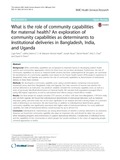| dc.contributor.author | Paina, Ligia | |
| dc.contributor.author | Vadrevu, Lalitha | |
| dc.contributor.author | Hanifi, Syed Manzoor Ahmed | |
| dc.contributor.author | Akuze, Joseph | |
| dc.contributor.author | Rieder, Rachel | |
| dc.contributor.author | Chan, Kitty S. | |
| dc.contributor.author | Peters, David H. | |
| dc.coverage.spatial | Bangladesh | en |
| dc.coverage.spatial | India | en |
| dc.coverage.spatial | Uganda | en |
| dc.date.accessioned | 2017-04-06T10:26:58Z | |
| dc.date.available | 2017-04-06T10:26:58Z | |
| dc.date.issued | 2016-11-15 | |
| dc.identifier.citation | Paina, L., Vadrevu, L., Hanifi, S.M.A., Akuze, J., Rieder, R., Chan, K.S. and Peters, D.H., 2016. What is the role of community capabilities for maternal health? An exploration of community capabilities as determinants to institutional deliveries in Bangladesh, India, and Uganda. BMC Health Services Research, 16(7), p.61. | en |
| dc.identifier.issn | 1472-6963 | |
| dc.identifier.uri | https://opendocs.ids.ac.uk/opendocs/handle/20.500.12413/12933 | |
| dc.description.abstract | Background:
While community capabilities are recognized as important factors in developing resilient health systems and communities, appropriate metrics for these have not yet been developed. Furthermore, the role of community capabilities on access to maternal health services has been underexplored. In this paper, we summarize the development of a community capability score based on the Future Health System (FHS) project’s experience in Bangladesh, India, and Uganda, and, examine the role of community capabilities as determinants of institutional delivery in these three contexts.
Methods:
We developed a community capability score using a pooled dataset containing cross-sectional household survey data from Bangladesh, India, and Uganda. Our main outcome of interest was whether the woman delivered in an institution. Our predictor variables included the community capability score, as well as a series of previously identified determinants of maternal health. We calculate both population-averaged effects (using GEE logistic regression), as well as sub-national level effects (using a mixed effects model).
Results:
Our final sample for analysis included 2775 women, of which 1238 were from Bangladesh, 1199 from India, and 338 from Uganda. We found that individual-level determinants of institutional deliveries, such as maternal education, parity, and ante-natal care access were significant in our analysis and had a strong impact on a woman’s odds of delivering in an institution. We also found that, in addition to individual-level determinants, greater community capability was significantly associated with higher odds of institutional delivery. For every additional capability, the odds of institutional delivery would increase by up to almost 6 %.
Conclusion:
Individual-level characteristics are strong determinants of whether a woman delivered in an institution. However, we found that community capability also plays an important role, and should be taken into account when designing programs and interventions to support institutional deliveries. Consideration of individual factors and the capabilities of the communities in which people live would contribute to the vision of supporting people-centered approaches to health. | en |
| dc.language.iso | en | en |
| dc.publisher | BMC Health Services Research | en |
| dc.rights.uri | http://creativecommons.org/licenses/by/4.0/ | en |
| dc.subject | Health | en |
| dc.title | What is the Role of Community Capabilities for Maternal Health? An Exploration of Community Capabilities as Determinants to Institutional Deliveries in Bangladesh, India, and Uganda | en |
| dc.type | Article | en |
| dc.identifier.externaluri | https://bmchealthservres.biomedcentral.com/articles/10.1186/s12913-016-1861-0 | en |
| dc.identifier.doi | 10.1186/s12913-016-1861-0 | |
| dcterms.dateAccepted | 2016-11-15 | |
| rioxxterms.funder | Default funder | en |
| rioxxterms.identifier.project | Default project | en |
| rioxxterms.version | VoR | en |
| rioxxterms.versionofrecord | 10.1186/s12913-016-1861-0 | en |
| rioxxterms.funder.project | c941507f-fd0b-4fc3-9822-4b2132f61a1d | en |


